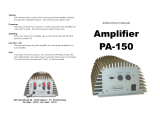5. Volume Control
This control allows the level or volume to be adjusted in order to achieve a balanced overall sound.
To get the balanced sound a selection of familiar music or film excerpts will need to be played. Start
with the volume at minimum and increase the level control until a balanced sound is established.
If using an AV processor or AV receiver amplifier, the system can be adjusted by the test tone
function within the set-up features. (Refer to the set up section in the AV processor or AV receiver
amplifier user guide.) When the subwoofer is correctly set-up, you should not be able to identify its
location easily in the room.
6. Bass Switch
This switch tailors the bass response of the subwoofer to your tastes. There are three settings:
Music, Movies and Impact. Movie mode provides a relatively flat response down to 35Hz. Music
mode is -2dB down on Movie mode but goes lower, all the way down to 30Hz. Impact mode is
+3dB up on Movie mode and comfortably goes down to 40Hz.
7. Phase Control Switch
The Phase Control is used to synchronise any delay between the subwoofer and main/ satellite
speakers. When the subwoofer is in phase with the main/satellite speakers the sound should be
full bodied. Sit in a normal listening position whilst adjusting the phase switch. Help from another
person may be required. When set correctly the location of the subwoofer should be almost
undetectable. Experimentation is advised in order to achieve optimum results. However it should be
noted that in most cases the phase control switch should be set to 0 degrees.
8. Power Mode Switch with On-Auto Facility
With the switch in the ‘On’ position, the subwoofer is permanently switched on under all conditions.
In the ‘Auto’ position the subwoofer will automatically switch on when an input signal is received.
It will remain on for a period of 15 minutes without receiving a signal before switching into standby
mode until a signal is received once more.
Additional Notes on the Auto On Function
When using the auto on feature, the subwoofer will “lock” onto the input it was activated by. In
most cases, when using either stereo or LFE input connection this will not matter. However, if using
both stereo and LFE connections, you will not be able to toggle between inputs until the subwoofer
has entered standby. This can be done manually by turning it off and on again, or by letting it time
out (15 minutes) before changing the inputs over.
9. Mains Power Switch
The Mains Power Switch should be switched to the ‘Off’ position when the subwoofer is unused for
extended periods. The switch must be in the ‘On’ position for the subwoofer to function.
WARNING: Due to the mains switch being located on the rear panel, the apparatus
must be located in the open area with no obstructions to access the mains switch.
10. IEC Mains Power Connector/ Fuse Location
The subwoofer is supplied with a two-pin mains input socket for connection to the mains supply.
Use ONLY the appropriate IEC mains lead provided with the product. Also fitted is an external
mains fuse. If this fuse blows during operation a spare fuse is provided within the fuse holder for
replacement. If you wish to change the fuse, you can do this by removing the IEC mains lead and
carefully levering out the original fuse from its holder below the IEC mains input socket (10a). If the
fuse blows again it is advisable to seek help from an authorised service agent. DO NOT attempt to
re-fit a further fuse as this could result in serious damage to the amplifier unit.
11. Mains Voltage Selector
This is factory set to your country’s mains voltage specification. Do not attempt to adjust this as
this may lead to permanent damage to the product and even the risk of fire. There is a clear plastic
cover over the selector to prevent accidental adjustment.
monitoraudio.com 7
ENGLISH














